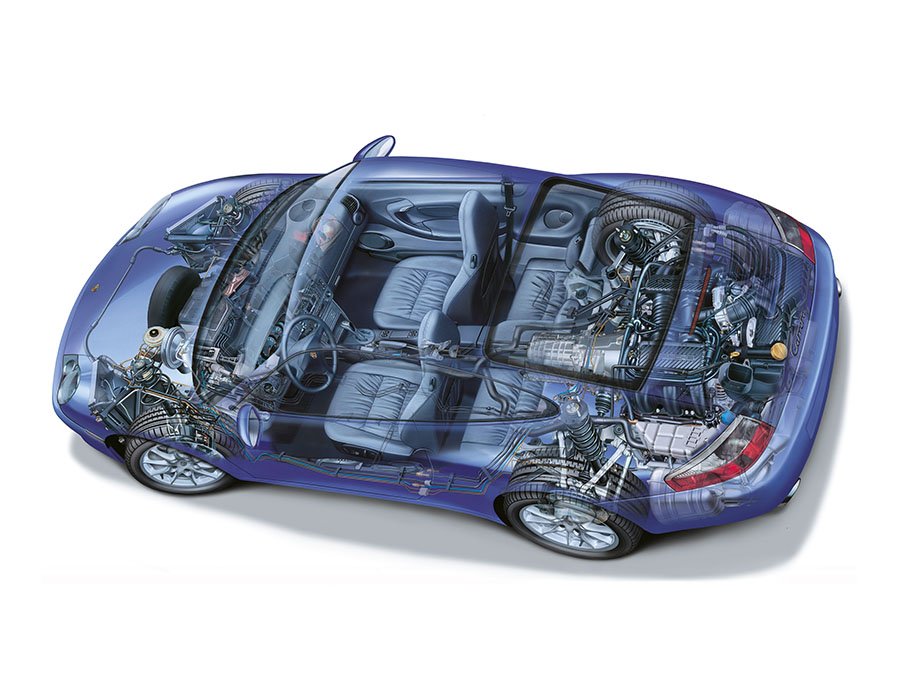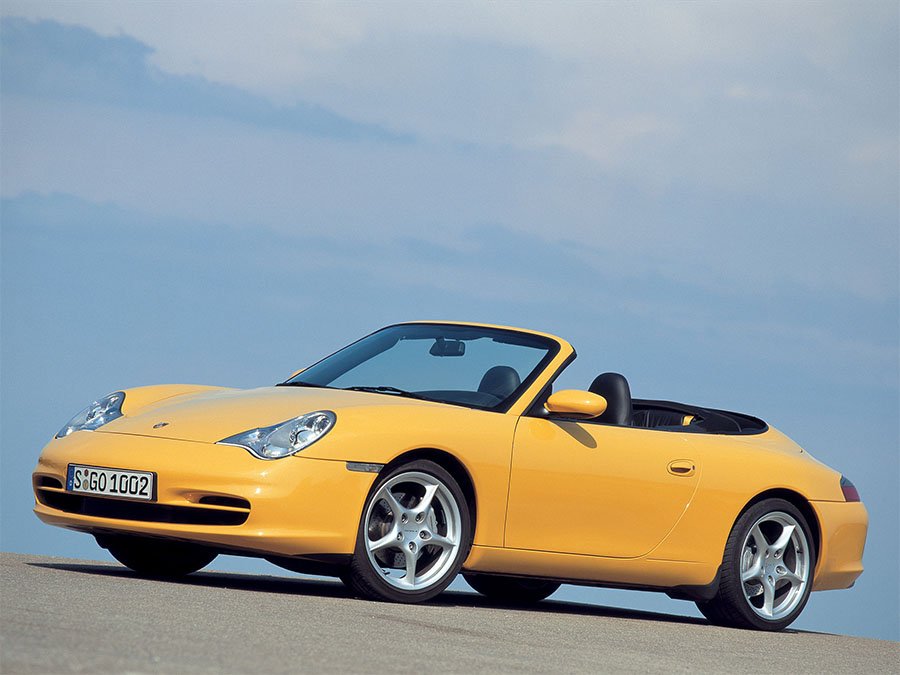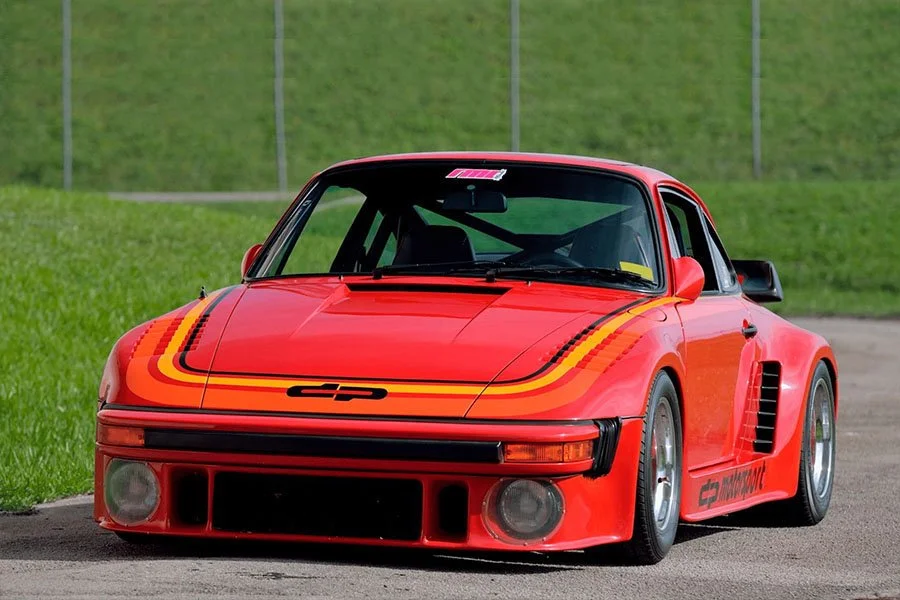Guide: Porsche 911 3.6 Carrera (996.2) - a Historical & Technical Appraisal
/BACKGROUND
When Porsche unveiled the 996 type 911 at the Frankfurt Motor Show in September 1997, it marked the biggest raft of changes yet seen to the firm’s Flat 6-powered icon.
Since going into production back in 1964, the 911 had relied upon an air-cooled engine that started out with a whisker under two-litres and eventually grew to nearly 3.8-litres. Turbocharged variants had also been created and the suspension layout got updated towards the end of production too, but throughout this period the 911’s compact steel monocoque had fundamentally remained intact from one iteration to the next which resulted in an unmistakable DNA between the 911, 930, 964 and 993.
However, by the early 1990s it was obvious that, in order to meet increasingly stringent safety and emissions standards and enable Porsche to adopt the latest manufacturing techniques, the 911 would have to change.
To that end, the 996 ushered in a bigger, more spacious bodyshell for the first time in the 911’s history. There was also a now water-cooled Flat 6 engine with dual overhead camshafts and four valves per cylinder. Importantly, a common parts strategy was adopted that saw the 996 and 986 Boxster share myriad components in an attempt to cut costs and streamline production.
The move ultimately proved successful for Porsche who, between late 1997 and mid 2001, sold nearly 110,000 examples of the rear-wheel drive 996 Carrera and four-wheel driver Carrera 4 which were offered in Coupe and Cabriolet body styles. This figure was even greater when the Turbo, GT3 and GT2-badged variants were taken into account.
Never a firm to rest on its laurels, Porsche introduced a second generation 996 Carrera for the 2002 model year at the Frankfurt Motor Show in September 2001. Retrospectively dubbed the 996.2 (with the original 996 becoming the 996.1), this latest iteration of the water-cooled 911 aimed to be faster and safer than before while adopting a fresh new look inspired by the aforementioned Turbo.
At its heart was an engine enlarged from 3.4 to 3.6-litres which Porsche hooked up to reinforced versions of both the six-speed manual and five-speed Tiptronic gearboxes.
As for the cosmetic makeover, it was an attempt to differentiate the 996 from the much less expensive Boxster which, from the front, had looked almost identical to its bigger brother.
Porsche also took the opportunity to add another pair of body styles to the range with the arrival of a Targa and Carrera 4S Coupe.
Like the old 993, the rear-drive-only 996.2 Targa featured a panoramic glass roof which slid back at the touch of a button to provide open air motoring but with all the security benefits of a Coupe.
Meanwhile, the four-wheel drive Carrera 4S was initially available exclusively in Coupe form. It offered a subtly tweaked version of the handsome wide-bodied look along with practically all the mechanical upgrades of the Turbo bar its forced induction motor. Two years later, Porsche added a Carrera 4S Cabriolet to the range.
CHASSIS
As per its predecessor, the 996.2 was based around a fully galvanised steel monocoque bodyshell.
Where this latest iteration differed was on account of its strengthened body structure with a view to offering enhanced safety, ride and handling. To this end, Porsche carried out extensive reinforcement of the roof frame, sills and seat pan area which yielded torsional stiffness gains of 25% for the Coupe and 10% for the Cabriolet.
Front suspension was via MacPherson struts while the back end used a multi-link arrangement. Lightweight alloy control arms were fitted along with coil sprung Bilstein dampers and anti-roll bars at either end.
Once again, cross-drilled and ventilated brake discs of 318mm diameter were fitted up front and 299mm at the rear. Four-piston Brembo aluminium monobloc calipers were used all round.
ABS was standard along with power steering.
Each 996.2 automatically came fitted with a set of new lightweight Carrera II wheels that featured five much slimmer spokes than before. Wheel size remained at 17 x 7-inches front and 17 x 9-inches rear, but front track was widened by 10mm and the wheel offset was 5mm less.
A 64-litre fuel tank was mounted underneath the front lid, up against the bulkhead.
ENGINE / TRANSMISSION
Although the 996.2’s updated appearance was its most obvious new feature, the most significant was undoubtedly the arrival of an enlarged 3.6-litre Type M96/03 big valve engine with new crankshaft, pistons and connecting rods to replace the outgoing 3.4-litre unit.
The M96/03’s additional 209cc was achieved thanks to a longer stroke (extended from 78mm to 82.8mm) while the 96mm bore diameter was carried over. Displacement went from 3387cc to 3596cc.
Another important feature was the VarioCam Plus two-stage valve timing and lift adjustment system as used on the Turbo and GT2. In addition to the variable cam positioning that provided continuously adjustable valve timing on the 996.1, VarioCam Plus also incorporated two camshaft profiles and two sets of tappets to vary both valve lift and duration for improved torque and fuel efficiency.
The M96/03 engine’s dual-stage resonance air intake system was optimised for its larger displacement which gave a further boost to mid-range power and torque.
Engine management was courtesy of the latest Bosch ME 7.8 instead of the outgoing M7.2 unit which notably reduced hydrocarbon emissions caused by heated fuel.
A new exhaust system with distinctive oval tail pipes resulted in less back pressure and gave a sportier sound.
The net result of these changes was an additional 19bhp with 315bhp now on tap at an unchanged 6800rpm (up from 296bhp).
There was also more torque on offer at an appreciably lower engine speed with 273lb-ft developed at 4250rpm instead of 258lb-ft at 4600rpm.
The rest of the M96/03’s characteristics were pretty much as before – it was an all-alloy water-cooled Flat 6 with dual overhead camshafts, four valves per cylinder and pent-roof combustion chambers. It ran an integrated dry-sump lubrication system with a traditional oil sump at the bottom of the engine (instead of a separate reservoir) and a scavenge pump at the non-drive end of each cylinder head that served to evacuate the oil from the heads and return it to the sump.
Compression was kept at 11.3:1.
Both the six-speed manual and five-speed Tiptronic gearboxes used in the 996.2 were reinforced.
Porsche increased the torque capacity of the manual transmission (Type G96/01 for the Carrera and G96/31 in the Carrera 4) by using a stronger alloy steel on key components, three instead of two bearings for the output shaft and stronger bevel gears for the differential.
The optional five-speed Tiptronic S unit (Type A96/10 in the Carrera and A96/35 in the Carrera 4) was newly imported from the Turbo with specially tailored lock-up torque converter and shift programmes for the normally aspirated engine. In ‘D’ mode shifts were made automatically using one of five settings based on driving style while in ‘M’ mode shifts were executed manually via steering wheel-mounted switches.
The four-wheel drive system in the Carrera 4 directed between 5% and 40% of the torque to the front wheels depending on available traction and power applied.
Porsche Stability Management (PSM) was standard on the Carrera 4 and an optional extra on the rear-drive Carrera. PSM was a sophisticated anti-skid control system that oversaw the ABS (anti-lock brakes), ASR (traction control), ABD (automatic brake differential) and EBV (electronic brake-force distribution). The PSM system was programmed to recognise when the limits of adhesion had been passed by taking inputs from individual wheel speeds, acceleration and deceleration.
BODYWORK
Externally, the 996.2 underwent a series of changes aimed at improving aerodynamics, cooling and visual appeal while further differentiating the 911 from the entry level Boxster.
A new front bumper came with re-shaped and enlarged intakes designed to increase airflow to the radiators and brakes. Small flexible spoilers ahead of the front wheels reduced lift.
Further up were Turbo-style headlights that required different front fenders to the 996.1.
The rear fenders were also new and subtly widened.
At the back was a rear bumper with a deeper apron and re-shaped cutaways for the oval exhaust tips.
Underneath, Porsche installed a new duct that improved transmission cooling by 20%.
Whereas the 996.1 Cabriolet had come with a plastic rear window, this latest iteration featured a heated glass unit that was detachable from the rest of the hood so that, in the event either the electric fabric roof or glass window were damaged, they could be changed independently of one another.
Unlike the old 993 Targa (which was based on a Cabriolet bodyshell), the new rear-drive-only 996.2 Targa was derived from the Coupe albeit using a roof reinforced with 30mm thick high tensile steel tubing to aid roll over protection and increase rigidity. That aside, its full-length panoramic glass panel that electronically slid back beneath the rear window followed a similar principle to before and was roughly twice the size of a regular sunroof.
When closed, an electric blind could be activated that gave protection from the sun and the Fastback glass rear window could be opened hatchback-style to give access to the rear seat / luggage area.
In addition to having offered a little more head and luggage space than a regular Coupe, the 996.2 Targa came with stiffer anti-roll bars to compensate for its slightly higher centre of gravity.
As before, body panels were steel with deformable plastic bumpers throughout the range. Also standard equipment on these normally aspirated models was an electronic rear spoiler that automatically rose into the airflow at 75mph and descended back down at 37mph.
INTERIOR
Inside, the second generation 996 Carrera came with a new lockable glovebox, integrated centrally-mounted cup holders, a three instead of four-spoke steering wheel, matt as opposed to gloss-finish switchgear, seatbelt tensioners with belt force limiters, a larger central air conditioning vent and the more comprehensive onboard computer from the Turbo.
Behind the three-spoke steering wheel was a traditional five-gauge dash with a centrally mounted 7000rpm rev counter. Off to the left was a speedometer and voltmeter while on the right was a combined oil temperature / fuel gauge and an oil pressure dial. Digital read outs at the base of the three main instruments provided the driver with all manner of additional information.
The rest of the switchgear was mounted on the central console along with the ventilation controls and audio system.
Electric windows, electric heated mirrors, leather upholstery and air conditioning were standard for all markets along with automatic climate control and remote central locking.
CARRERA 4S COUPE
As well as the Targa, the other new addition to the 996.2 range was the Carrera 4S Coupe.
Perhaps the ultimate normally aspirated 911 this side of a GT3, the Carrera 4S incorporated the wide-bodied look of a Turbo but without the complex forced induction engine, ugly rear fender-mounted intercooler ducts or rear spoiler.
At the back of the car Porsche installed a traditional full-width reflective strip. Up front, a custom chin spoiler was fitted to maintain the aerodynamic balance with the conventional retractable spoiler of the type fitted to the rest of the normally aspirated Carrera range.
Under the skin, a Turbo brake system (also shared with the GT3) comprised 330mm diameter cross-drilled and ventilated discs plus four-piston aluminium monobloc Brembo calipers finished in high gloss red paint.
Suspension-wise, the Carrera 4S sat 10mm lower than a regular 996.2 Carrera 4. It also featured custom springs, dampers and anti-roll bar rates.
8 and 11 x 18-inch Turbo II wheels were fitted front to rear respectively. The rest of the running gear was pure Carrera 4.
Full leather upholstery came as standard along with electric seats and an audio system upgrade while metallic paint was offered as a no cost option.
OPTIONS
Porsche introduced a number of new or revised optional extras for the 3.6-litre 996 Carrera to include Porsche Communication Management 2 with CD player (instead of the original PCM with cassette player.
Bi-Xenon gas-discharge headlights were also new along with a digital Bose audio system, more discrete parking sensors and a remote entry system linked to the memory seat function when electric seats were specified.
The optional 18-inch diameter wheels were now 8 and 10-inches wide front-to-rear (up from 7.5-inches at the front previously). Buyers could choose from Carrera II, Turbo Look II and SportTechno rims along with split-rim SportsClassic and SportDesign styles. Painted wheel centres could be specified in any colour.
The most desirable optional upgrade was the X51 power kit which took the power output to 345bhp. These Type M96/03S motors featured a GT3 sand cast aluminium intake manifold, new cylinder heads with optimised CNC-milled inlet ducts, uprated camshafts, a modified oil pan, big bore exhaust manifolds and a re-mapped DME control module. An additional front-mounted radiator was also installed (except on the Carrera 4S).
Other performance-enhancing options included a sports chassis kit (30mm lower ride height with stiffer spings and dampers), a limited-slip differential, hard-backed sports seats or GT3 buckets (also available with painted backs), a short shifter and sports exhaust.
Sporty cosmetic options included a new aero kit (special front bumper, side skirts and fixed rear spoiler), coloured brake calipers and wheel spacers.
To add an extra touch of luxury and personalisation inside, Porsche offered extended leather, two-tone upholstery, heated memory seats, Porsche crested headrests, draped leather, coloured seatbelts, coloured instrument faces, an electric sunroof (Coupe only), a choice of audio systems, an in-car telephone (or telephone preparation) and a choice of wood, aluminium or carbonfibre inserts (to include for the steering wheel, gear knob and handbrake lever).
For added practicality there was the aforementioned Tiptronic gearbox, Porsche Communication Management 2 and a roof rack.
Given suitably deep pockets, practically any level of customisation could be requested through Porsche’s Exclusive department.
WEIGHT / PERFORMANCE
The 996.2 Carrera Coupe weighed in at 1345kg, had a top speed of 177mph and 0-62mph time of 5 seconds (compared to 1390kg, 171mph and 5.2 seconds respectively).
The 996.2 Carrera Cabriolet weighed 1425kg (up from 1420kg). Top speed was 177mph and 0-62mph took 5.2 seconds.
The all-wheel drive Carrera 4 versions were 60kg heavier, but Porsche quoted identical performance figures.
The 996.2 Targa tipped the scales at 1415kg, had a 177mph top speed and 5.2 second 0-62mph time.
In terms of the Carrera 4S Coupe, this variant weighed 1445kg, had a 174mph top speed and 0-62mph time of 5.1 seconds.
Tiptronic versions were 45kg heavier, typically had an 3mph slower top speed than their manual counterparts and were around half-a-second slower from 0-62mph than their manual counterparts.
2003 MODEL YEAR
For the 2003 model year (production of which began in September 2003), Cabriolet variants of the 996.2 came with a roof that could be raised or lowered while on the move at speeds of up to 50kmh (30mph).
2004 MODEL YEAR
For the 2004 model year (production of which began in September 2003), Porsche offered two new 996.2 variants: the Carrera 4S Cabriolet and rear-drive Carrera-based 40 Jahre 911 Limited Edition.
CARRERA 4S CABRIOLET
The Carrera 4S Cabriolet was an open top version of the popular 4S Coupe launched two years prior.
The structure of the Carrera 4S Cabriolet was slightly stiffer than the standard Carrera 4 Cabriolet: torsional stiffness was increased by 4.5% and flexural stiffness by 3% but this came with an additional weight penalty (taking the total to 1565kg).
In six-speed manual trim top speed was 173mph and 0-62mph took 5.3 seconds.
Tiptronic variants were 45kg heavier, had a 170mph top speed and 0-62mph time of 5.8 seconds.
40 JAHRE 911 LIMITED EDITION
At the Frankfurt Motor Show in September 2003, Porsche unveiled a special edition 996.2 to celebrate 40 years since the original 911’s 1963 unveiling.
The resultant 40 Jahre 911 was a rear-drive Carrera Coupe-based variant fitted with the X51 power kit, limited-slip differential, chrome tailpipes, chrome 18-inch Carrera II wheels and the Sports suspension pack (except in North America where standard suspension was used).
Each car was painted the same exclusive shade of GT Silver (as used on the Carrera GT) and fitted with large Turbo-style front bumper intakes with body coloured slats.
A 911 instead of Carrera script was used on the engine lid and each of the sill plates.
Interior equipment included natural Dark Grey leather upholstery, alcantara rooflining, body-coloured and heated hard-backed Sports seats, body coloured instrument bezels and a body coloured centre console insert. Located at the base of the central control panel was a 911 script, under which was a numbered 40 Jahre Limited Edition plaque.
Each of the 1963 cars built was also supplied with a two-piece set of fitted luggage (a large and small suitcase) plus a matching leather wallet and key pouch.
2005 MODEL YEAR
The 996.2 Carrera and Carrera 4 in Coupe and Cabriolet body styles were discontinued from for the 2005 model year (production of which began in September 2004) to make way for the heavily revised 997 variant.
Meanwhile, production of the Carrera 4S and Targa continued for one more year (along with the Turbo, GT2 and GT3).
END OF PRODUCTION
By the time 996.2 production came to an end in August 2005, some 68,105 examples had been completed outside of the Turbo, GT2 and GT3-badged models.
This figure was split accordingly:
Carrera Coupe: 14,629 units
Carrera Cabriolet: 14,961 units
Carrera 4 Coupe: 3231 units
Carrera 4 Cabriolet: 7155 units
Targa: 5089 units
Carrera 4S Coupe: 17,283 units
Carrera 4S Cabriolet: 5757 units
Text copyright: Supercar Nostalgia
Photo copyright: Porsche - https://www.porsche.com































































